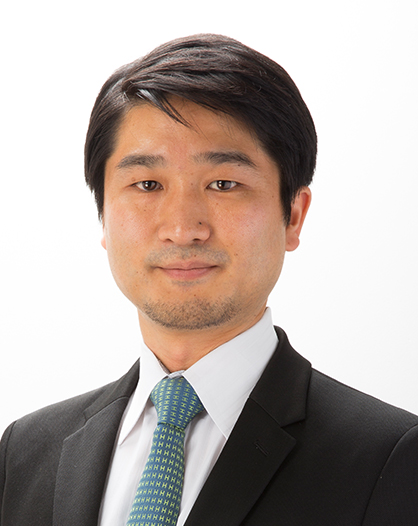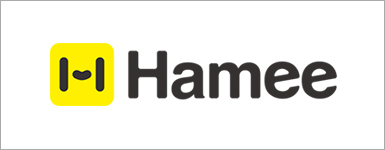| Hamee Corp. (3134) |
|
||||||||
Company |
Hamee Corp. |
||
Code No. |
3134 |
||
Exchange |
TSE 1st Section |
||
Industry |
Retail (commerce) |
||
President |
Atsushi Higuchi |
||
Address |
Odawara EPO, 2-9-39, Sakae-cho, Odawara-shi, Kanagawa prefecture |
||
Year-end |
April |
||
URL |
|||
*The share price is the closing price on December 22. The number of shares issued was obtained by subtracting the number of treasury shares from the number of outstanding shares as of the end of the latest quarter. BPS takes into account share splits.
|
||||||||||||||||||||||||
|
|
*The forecasted values were provided by the company. From FY4/16, net income is profit attributable to owners of the parent. Hereinafter the same apply.
*400-for-1 share split in Dec. 2014 and 4-for-1 share split in Mar. 2016, and 2-for-1 share split in Nov. 2016. These share splits were taken into account when calculating DPS and EPS for the term ending Apr. 2017. |
| Key Points |
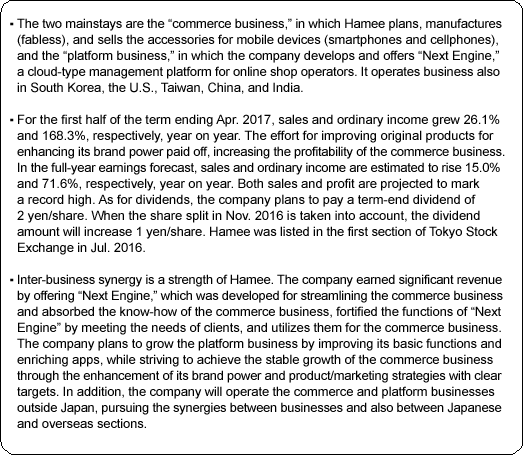 |
| Company Overview |
|
In addition to the company itself, the Hamee group consists of 3 consolidated subsidiaries including Hamee Korea Co., Ltd. (Korea), Hamee US, Corp. (the United States), and Hamee Taiwan, Corp. (Taiwan) (Hamee Corp. wholly owns these 3 subsidiaries), and 4 affiliated companies including Hamee India Pvt. Ltd. (India), Hamee Shanghai Trade Co., Ltd. (China), ROOT Inc., and Web No Takumi Co., Ltd.  Commerce Business: Domestic online sale, wholesale, and sales to foreign customers
Hamee Corp. conducts product planning and production (as a fabless manufacturer), and purchase of general goods including mobile phone accessories, and sells such goods over the Internet to general consumers (retail) as well as through wholesale to major retail stores of general goods, electronics and home appliances, and the like. As for online sale, in addition to the domestic business, the company runs e-commerce websites for foreign general consumers and has opened their online shops in overseas e-commerce shopping malls, etc. through their overseas subsidiaries (cross-border e-commerce).
Domestic online sale (retail): 17 e-commerce stores in Japan
The company owns 17 e-commerce stores in total in Japan, including 1 store on the website with their own domain, 5 stores in Rakuten Market, 4 stores in Yahoo! Shopping Mall, 1 store in Amazon.co.jp, 1 store in DeNA Shopping Mall, and other small online stores, offering mobile phone accessories and the like to general consumers. In running these web stores, they attach weight to UX (User Experience: totality of experiences that a user can get by using or consuming a product or service) and their special team takes a multitude of measures to improve UX. The company deals with call center operations by themselves without outsourcing such operations to any outside companies.
Wholesale: Sale to retail stores and e-commerce operators
In addition to wholesale of mobile phone accessories chiefly to leading retail stores of general goods, and electronics and home appliances, they have developed a website for online wholesale to e-commerce operators. The headquarters of the company is located in Odawara (Kanagawa prefecture), and they have branch offices in Tokyo and Osaka and post personnel called rounder who provide support for creating sales floors in physical stores.
Sale to foreign customers: Online sale to general consumers by their subsidiaries in South Korea, the United States, Taiwan, and China
As of the end of the term ended April 2016, their Korean subsidiary opened a total of 11 online stores including 1 store on the website with their own domain and 10 stores in e-commerce shopping malls in South Korea. In addition, their American subsidiary started 13 online shops in total including 2 stores on the websites with their own domains and 11 stores in Amazon and eBay for North America and Europe. Furthermore, their Taiwanese subsidiary launched 5 online stores in e-commerce shopping malls in Taiwan such as Yahoo! Shopping Mall. In the first half of the term ending April 2017, three online shops, including 1 shop on the website with their own domain, were opened in China.
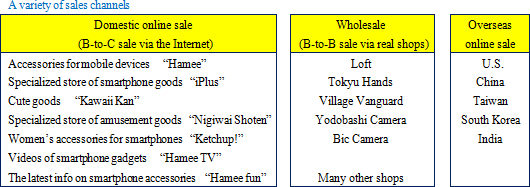  Platform Business: Provision of systems developed and improved in the commerce business segment to the outside
The Company developed "Next Engine," a management platform that uniformly manages back-office operations necessary to run online shops, and offer it to e-commerce operators who sell products over the Internet through their own websites, online shopping malls, and the like. "Next Engine" is a system for e-commerce back-office operations, which was developed by the Hamee group in the course of expanding their e-commerce business, as well as a backbone system which is used in the commerce business segment of their corporate group.
Provision of "Next Engine," an operation management platform for operators who sell products via the Internet, with the cloud technology
"Next Engine" is a cloud system that automates the process of online store operations and assists e-commerce operators in enhancing their management efficiency, with various functions such as automatic e-mail response, comprehensive management of order slips, automated coordination of goods in stock, and comprehensive uploading of web-pages of products. Because this system enables uniform management of multiple online shops in several different online shopping malls and synchronization of the quantity of stock displayed on the website of various individual online shops, e-commerce operators who own a number of online stores can receive considerable benefits by using this system."Next Engine" is composed of the main functions (standard specifications) and applications (extended functionality; hereinafter referred to as the "apps"), allowing users to choose appropriate functions depending on their needs. Standard functions contributing to the the convenience of e-commerce operators are installed on the main functionality in one package, while the apps are considered as options to satisfy unique needs that the standard functions cannot meet. "Next Engine" is provided also by OEMs; GMO solution partner, Inc. offers the system in the name of "Stock Manager" and GMO Commerce, Inc. provides it as "Sugoi! Net-Shop Kanri" (which literally means great management of online shops), respectively to their customers. The basic rate for "Next Engine" is determined based on the pay-as-you-go system where fees are dependent on the number of orders each e-commerce operator gains (this is a rate structure that is in proportion to the business scale of each user). In addition, multitudinous services such as the special server plan and customization (custom-made Next Engine) are also available with fees charged separately to each customer. The fees of apps on Next Engine vary for each application (free of charge, based on the flat-rate or pay-as-you-go system). 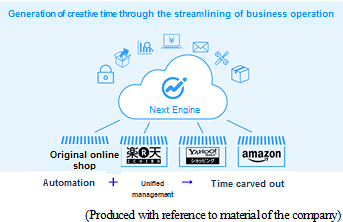 "Next Engine" automates the routine tasks for online shops as much as possible.
Unified management of multiple shops, including your own online shop and those in leading online malls. The improvement in work efficiency would reduce overtime work and carve out time for sales strategy and product development. Business activities and support: Self-development of support for users, independently of outside companies
The company seeks prospective customers by exhibiting products and services at events, seminars and the like targeted at e-commerce operators, and a team formed with staff in charge of business activities and staff responsible for support operations conducts business activities including consultation, in order to win contracts. Besides, the "Partnership System," where subcontracting companies carry out business activities on behalf of Hamee, has been established. On the other hand, support for users of "Next Engine" is provided solely by Hamee, independently of any outside companies. Aiming to increase customer satisfaction, a special team is appointed for each user and team members with expertise handle customers' issues such as burdens incurred on customers at the time of introduction of "Next Engine," concerns about using "Next Engine," and troubles.
Development: Hamee's strong point is that they themselves are a user of "Next Engine."
They developed "Next Engine" in their own development department, establishing a structure that enables prompt action to changes in systems of e-commerce shopping malls (some apps have been developed in cooperation with companies that forge partnership with Hamee). In order to make "Next Engine" a system which prioritizes the convenience of users, from the users' perspective, Hamee utilizes "Next Engine" as a business tool at their own online stores. The close cooperation between the platform and commerce business segments is one of the strong points of the company.
Platform development
Furthermore, they published the API (*) of "Next Engine" in December 2013, achieving so-called platform development of "Next Engine" which makes it possible to offer on "Next Engine" myriads of applications developed by the company or other outside developers, etc. This allows establishment and operation of systems, according to the circumstances of each user company, by coordinating apps and "Next Engine."
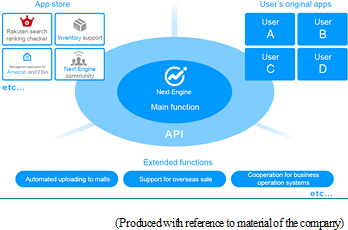 *API (Application Programming Interface) means an interface for reading the functions, data, etc. of a computer program (software) from an external program easily and using them. Here, an interface means specifications regarding function reading procedures, description methods, etc. The functions that are compatible with API do not need to be developed from scratch, and so this makes it possible to develop programs efficiently.
Total number of contracts
As of the first half of the term ending April 2017, the total number of companies that subscribe to "Next Engine" is 2,457 (up 229 from the end of the term ended April 2016), and the number of stores using "Next Engine" is 18,541 (up 1,748 from the end of the term ended April 2016). The total turnover of the stores using "Next Engine" is 172.2 billion yen in the first half of the term ending April 2017 (the total turnover for the full fiscal year ended April 2016 was 315 billion yen).
 Expansion to overseas markets
The company's basic strategy is "to develop and release the localized version (overseas version) of "Next Engine" after actually operating e-commerce at local corporations in foreign countries and cultivating know-how such as cooperation with e-commerce shopping malls in each country."
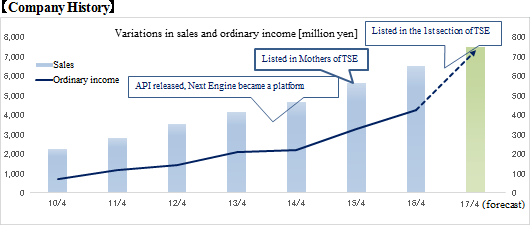 In November 2007, the company released "Next Engine," a cloud back-end solution system for e-commerce operators. Then, in May 2008, services of "Next Engine" were made available to outside companies. In June 2011, they opened an e-commerce website, "StrapyaWorld," on "Amazon U.S." in the United States for international customers, launching cross-border e-commerce. In October of the same year, the Korean subsidiary was set up. In May 2013, the company name was changed to Hamee Corp., and the American subsidiary was established. In December, they published API of "Next Engine" to develop a platform for it. In April 2015, the company was listed on the Mothers (Market of the high-growth and emerging stocks) of Tokyo Stock Exchange. They established the local subsidiaries in Taiwan and China in July and in India in September 2015. In February 2016, they newly established "Next Engine AI Lab" which conducts research on artificial intelligence and machine learning. The company was selected by the Ministry of Economy, Trade and Industry as well as Tokyo Stock Exchange as one of companies of the "Competitive IT Strategy Company 2016" in June, and changed their stock market listing from the Mothers to the 1st section of Tokyo Stock Exchange in July. In August 2016, they set up "ROOT Co., Ltd." which sells goods for smart phones useful in outdoor activities. |
| 1H of Fiscal Year April 2017 Earnings Results |
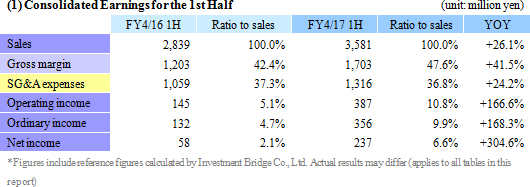 Since profitability improved due to the increase in the ratio of original products, operating income rate rose 5.7% to 10.8%.
Sales were 3,581 million yen, up 26.1% year on year. Due to the favorable performance of iFace Series, etc., the sales of the commerce business, mainly wholesale, grew 26.5% year on year. Since companies that subscribe to the main functions and apps of "Next Engine" increased, the sales of the platform business increased 23.7% year on year.As for profit, gross profit rate rose 5.2% to 47.6%, due to the effect of sales growth and the improvement of the ratio of sales in the commerce business (increase in the ratio of sales of original products). The augmentation of SG&A due to the increases in variable cost, personnel expenses (up 56 million yen), commission paid (up 33 million yen), advertisement cost (up 19 million yen), the amortization of trademarks (up 15 million yen), etc. was offset, and operating income grew 166.6% year on year to 387 million yen. Non-operating expenses augmented as the cost for changing markets to the first section of Tokyo Stock Exchange amounting to 22 million yen was posted, and special losses increased, but net income grew 304.6% to 237 million yen due to the application of tax effect accounting. 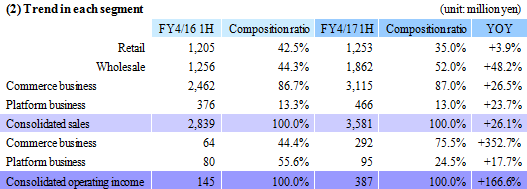 Commerce business
Sales were 3,115 million yen (up 26.5% year on year), and segment profit was 292 million yen (4.5 times y/y). Due to the favorable performance of iFace Series, etc., the sales from wholesale to mainly leading mass retailers increased 48.2% year on year, and the sales from retail via Hamee's own website and Amazon grew 3.9% y/y. The sales of a Korean subsidiary, which conducts wholesale, rose. The reason why the increase in sales from retail was small is that production output dropped temporarily as Hamee shifted to the in-house production of iFace Series. Since products were first allocated to preordered wholesale, the company lost some chances to sell products in retail. In addition, customers refrained from buying before the release of iPhone 7, and this affected the company's retail performance.As for profit, the ratio of sales from wholesale increased and the ratio of sales of original products rose. Consequently, profit rate grew 6.8% year on year from 2.6% to 9.4%. There is a significant difference between retail and wholesale in gross profit rate, but the difference in operating income rate is not significant because of the difference in selling efficiency. Platform business
Sales were 466 million yen (up 23.7% year on year), and segment profit was 95 million yen (up 17.7% y/y). The number of companies that subscribe to the main functions and apps of "Next Engine" increased steadily. Profit rose due to sales growth, but the profit rate of this segment declined 1.0% from 21.4% to 20.4%, because the company invested in personnel for improving apps from the second half of the previous term to the beginning of this term (the profit rate is as estimated). The number of companies that subscribe to the main functions of "Next Engine" as of the end of the first half is 2,457, up 19.0% from 2,065 at the end of the same period of the previous term (2,228 at the end of the previous term), and the number of companies that subscribe to apps is 791, up 105.5% from 385 at the end of the same period of the previous term. The number of stores increased by 1,748 from 16,793 to 18,541. The number of companies that subscribe to apps means the number of users who subscribe to one or more paid apps of Hamee or another company.
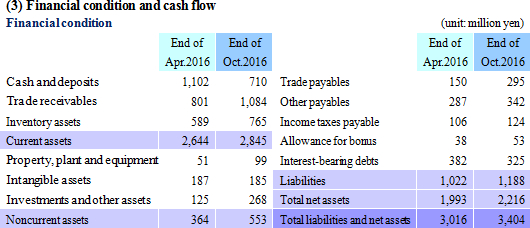  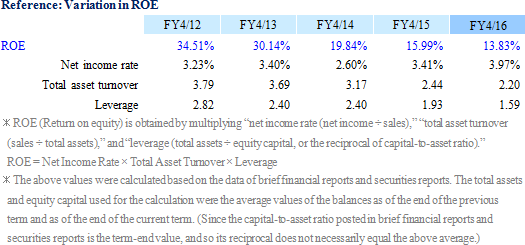 |
| Fiscal Year April 2017 Earnings Estimates |
 According to the upwardly revised earnings forecast, sales and operating income are estimated to increase 15.0% and 70.8%, respectively, year on year
The full-year earnings forecast has been revised upwardly, as the profitability of the commerce business improved thanks to the favorable performance of original products beyond expectations. The company made efforts to develop and release new products with the growth strategy for this business: "To enhance brand power by strengthening original products," and such efforts are paying off.The two reasons for the upward revision to profit are the growth of gross profit due to the ratio of sales of original products exceeding the initial estimate and the relative drop in logistics cost due to the unit selling price of products rising in the commerce business. Full-year operating income rate is forecasted to increase considerably from 6.9% in the previous term to 10.3%. As for sales, the initial estimate has not been changed, as "sales have been almost as first estimated" in the commerce business, which is a reason for the upward revision to profit. 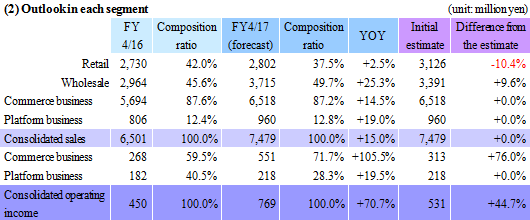 As for the platform business, since the company finished increasing development staff in the first half, the improvement in profit rate is expected in the second half (20.4% in the first half → 24.9% in the second half). Consequently, the full-year profit rate for this business segment is projected to increase from 22.6% in the previous term to 22.7%. (3) Dividend policy
Since "it was judged that the cycle of reinvesting profit for stable earning and growth had been well-established as the business performance had been healthy," the company paid the first dividend of 3 yen/share in the term ended Apr. 2016. In the term ending Apr. 2017, the company plans to pay a term-end dividend of 2 yen/share (the actual dividend taking into account the share split in Nov. 2016 is 4 yen/share, up 1 yen/share). The company plans to pay dividends with a payout ratio of around 10% for the foreseeable future, but aims to achieve a stable payout ratio of 20-30% in the future.
|
| Strengths and Growth Strategies -Interview with President Higuchi |
|
Could you explain the advantage of handling everything from manufacture to wholesale and retail?
Being able to utilize the information gained through retail and wholesale for product development. We can grasp trends in both retail and wholesale in order to create products, and then roll them out online (retail) and in real stores (wholesale). We have been in the mobile business for almost 20 years, and smartphone accessories are currently our focus, but we started out with cell phone straps. Even when the cell phone strap business stopped growing, we were able to expand our business by developing new products. We can perceive trends both online and in real stores, and link these to our product development. Accordingly, if the smartphone accessory business were to slow down in future, I do not believe it would affect our activity, and we are also making efforts to deal with that possibility.When a market grows rapidly, there will be many new entrants to the market and the competition can be fierce. In the field of smartphone related products, apparel manufacturers once entered the market. However, these companies tend to withdraw quickly, and the number of competitors has decreased. The market conditions are therefore not too bad. Your profit percentage in the commerce business for the first half was 9.4%. Is this high profit percentage also due to your integrated process that starts with manufacturing?
By taking advantage of the functions as a fabless manufacturer, we made an effort to increase the proportion of our in-house products (developed and manufactured in-house), and that effort is paying off. Our in-house products are increasing, and include products like the "iFace Series" smartphone cases, and merchandise featuring Disney characters. We used to focus on stocking and retailing products, but now in-house products have come to account for about 60%. We've arranged a system where we make the products ourselves, and then sell them ourselves through wholesale and retail.
Could you explain your strategies for growth in the commerce business?
We will continue to improve our brand by strengthening our in-house products. As I mentioned earlier, in-house products now account for around 60% overall. As we already have business partnerships for wholesale with leading retailers, rather than increasing buyers, we will put effort into strengthening relations with current business partners. In order to do so, it will be necessary to strengthen our in-house products and improve our brand. We have been able to set up a "Hamee Corner" on the first floor of the Kansai branch of a leading mass retailer. I want to make it possible for us to expand this kind of idea to other stores and mass retailers. Meanwhile, when it comes to online retail, the strength of the appeal to the target market greatly depends on how the site is created and displayed. I want to put serious thought into creating websites that make the target market clear by diversifying the brands. We have already begun working on several brands, including "ROOT CO.," mobile gear suitable for the outdoor activities, "Kawaii Kan," specializing in cute goods (and handling character merchandise), and "Ketchup!" smartphone accessories targeted at girls. As we have the "Next Engine," even if we develop numerous brands and stores (such as "Hamee" mobile accessories and goods stores on Amazon, Rakuten, and Yahoo shopping) we will not incur any great cost. The proportion of our in-house products is also increasing, meaning that as well as the need to consider what kinds of products we want to develop, there is a need to further strengthen the management of each product. In stocking and selling, while our wide range of products is one of our strengths, we are also able to respond flexibly based on trends. However, as we improve our manufacturing function this will become more difficult. A product lineup is necessary, but we also need sales that do not always rely on the product lineup, and for that reason we need to improve our brand power. Under what circumstances did your company, formerly in the EC business, enter the platform business?
Initially, the aim was to streamline the company's own operations, but on the way we discovered direct sales and ended up proceeding with development in that direction. Just as we were being told, "It's impossible to operate online shopping business successfully with a unit price of less than ¥5,000," we were pricing our cell phone straps at around ¥1,000 and won a success. We were so busy that even part time employees weren't going home until midnight, and so we tackled the issue of moving the IT forward in the early stages. We were using existing systems and outsourcing development, but it didn't go well, and so we thought, "Let's make the system ourselves." So, we employed an engineer (the current CTO and CCO, Mr. Junya Suzuki) and began creating our own unique system.When we reached this point of integrity, we began to think we might also be able to handle direct sales, and we continued to develop with this in mind. We began direct sales in 2008, but we were the last entrant to the market. However, at the time there were no centralized cloud systems for orders and inventory management, and the "Next Engine" was a first for the industry. Moreover, having started late, we were able to begin using cloud services before others. Big businesses may be using the same systems for in-house development, but an overwhelming number of companies are still using manual procedures, and they are the potential customers for the "Next Engine." What's more, businesses with in-house development can also make use of API and link to the "Next Engine," allowing them to further improve their functions. 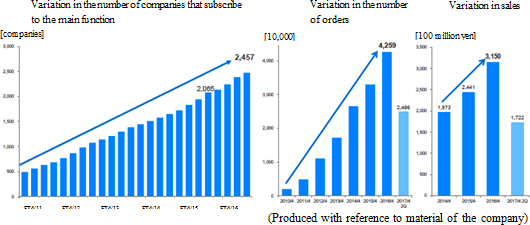 "Next Engine" has absorbed the know-how of the commerce business. What can you tell us about the growth strategies for the platform business?
Ultimately, I would like a system where the company can devote itself to the development of faster databases and API, while other companies take on app development. If the main functions become more attractive as a result of the development of fast databases and API, then the number of customers (the number of companies with membership contracts) will increase, and so the number of apps will also increase. With more apps, the added value of "Next Engine" will increase, and the number of users will grow even further. This will be linked to profit for the company and for companies developing the apps, and also improvements in customer satisfaction.Our current goal is 5,000 users. I believe that when we reach this scale, we will have increased our presence as a platform, and our development and use of apps will become more active. The amount of data at our disposal will also increase, and solutions through things like big data analysis will also become a possibility. In February, we established the "Next Engine AI Lab (current research room)" for research into AI and machine learning, and started full-scale research. I believe that because we are not involved in the commerce business simply to provide a sample for the "Next Engine," but by engaging in it seriously, we are achieving synergy with the platform business. In order to grow the platform business, we will continue making serious efforts towards the commerce business.  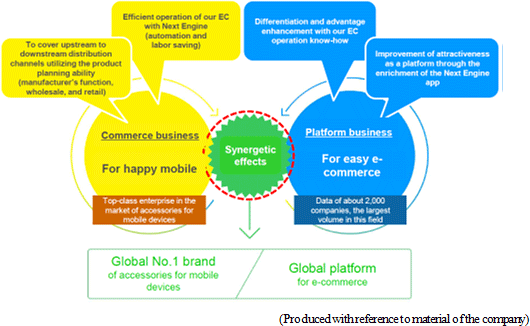 Could you tell us about the efforts to advance into new markets?
We are carrying out EC in the U.S. through things like the local subsidiary's website, "hamee.com." We have also completed development of an app for automatic coordination with the sites of the EC leader Amazon, and the next biggest, eBay, and we have prepared a system to support cross-border EC.In China, the local subsidiary has a store (strapya.world.taobao.com) with Taobao, an online shopping site operated by the Chinese EC industry leader Alibaba Group. We will be putting serious effort into local EC, proceeding with the required informatization, and creating a Chinese version of the "Next Engine." When the Chinese "Next Engine" is complete, it will, of course, be used by Japanese businesses carrying out EC in China, but also by Chinese businesses. By linking the Chinese and Japanese "Next Engines," it will become easier to carry out two-way EC between Chinese and Japanese businesses. Also, in October we began cross-border EC through the Alibaba Group's cross-border EC platform, TMALL GLOBAL, and China's second largest EC group Jindon's cross-border EC platform, JD Worldwide. We will continue to develop apps for coordination while carrying on with cross-border EC. Depending on the app, TMALL GLOBAL and JD Worldwide operations may be dealt with on the "Next Engine" screen. In South Korea, the local subsidiary operates "hamee.co.kr," and carries out wholesale, becoming profitable in the commerce business. We are also providing a free beta version of the Korean "Next Engine." As well as perfecting it and increasing its popularity, we would like to make it a fee-paying service. In Taiwan the local branch is running a store (tw.mall.yahoo.com/store/hamee_taiwan) on "Yahoo Taiwan." We have also established a local branch in India. I believe that in addition to the future market potential, as it is in the English speaking region, it can also support and develop American back-office related operations. We are currently carrying out the manufacture of original products, EC through opening stores in malls owned by local companies, wholesale, administration of an online shopping site aimed at the U.S., American EC back-office operations, and contracting some operations to external companies. As online shopping in India is based around online shopping platforms derived from Amazon, its special characteristic is that it is easy to use the know-how and technology from the Japanese "Next Engine" for things like stock centralization and operation integration and automation. The Indian operations have a basis in English, and a basis in Amazon. Therefore, I believe it will be possible to utilize a system made in India in America too. We certainly have big plans. As well as grasping the EC situation of each country and getting deep into the commerce business, we will also advance into the platform business and create a network of the various countries' platforms. Along with making "Next Engine" a platform indispensable to EC, I would like to enable users to operate cross-border EC. So, in addition to the synergy between the commerce and platform businesses, we can also anticipate synergy between the domestic and overseas businesses. Thank you for explaining some of the details to us.
Finally, could we have a message for your investors? |
| Conclusions |
|
|
| <Reference: Regarding corporate governance> |
 ◎ Corporate Governance Report Updated on Nov. 1, 2016
The Hamee group set the corporate philosophy: We Create the Best "e" for the Better "e" World, and recognizes that its primary missions are to strengthen its corporate governance systems and promote the corporate philosophy in order to achieve sustainable growth and improve shareholder value. The company also strives to boost the supervision function of the board of directors and secure the soundness and transparency of business administration by hiring an outsider director and three external auditors. The directors and all employees of Hamee will observe laws, regulations, and the articles of incorporation, fulfill their duties under sound social norms, strive to enhance risk control and supervision functions, and improve the soundness and transparency of business administration.
<Basic policy> <Reasons for Non-compliance with the Principles of the Corporate Governance Code (Excerpts)>
In the EC market surrounding Hamee, technological innovations and industrial changes are frequent, and it is very difficult to predict future earnings. Accordingly, it is considered that medium to long-term quantitative earnings forecasts does not always contribute to the appropriate judgments of stakeholders, and so the company does not disclose the numerical goals in its medium-term managerial plan. The causes of the differences between annual estimates and results are analyzed regularly, and the company discloses and explains them to stakeholders, including shareholders, through the announcement of financial results, etc. <Disclosure Based on the Principles of the Corporate Governance Code (Excerpts)>
The basic policy of Hamee is not to have so-called strategically held shares (e.g. cross-held shares). As of now, the company does not have such shares. Hamee basically does not make transactions with related parties, unless it is guaranteed that it is reasonable to make the transactions and the conditions for the transactions are appropriate and they would not reduce the profit of the Hamee's group. When starting any transactions with related parties, the company will carefully judge whether the above items are guaranteed, and wait for a resolution of the board of directors, etc. in accordance with the Companies Act, Hamee's rules for internal approval and regulations for authority of management. In addition, the company regularly confirms with executives whether they have any transactions with related parties, and discloses facts through securities reports. Hamee puts importance on constructive dialogues with shareholders and others, in order to contribute to the sustainable growth of the company and the mid to long-term improvement of corporate value, and makes efforts to increase opportunities for the president, directors in charge of IR, and staff of the planning and IR section to communicate with shareholders and investors. The planning and IR section holds a weekly meeting with the accounting and general affairs departments, to keep organic cooperation. As of now, the company holds a session for briefing financial results that is attended by the president twice a year, meetings with domestic and overseas institutional investors when necessary, telephone interviews, a briefing session for individual investors several times a year, and so on. The results of these events are reported to the board of directors. At the time of dialogue with shareholders, the company takes rigorous measures for preventing the leak of insider information. Disclaimer
This report is intended solely for information purposes, and is not intended as a solicitation to invest in the shares of this company. The information and opinions contained within this report are based on data made publicly available by the Company, and comes from sources that we judge to be reliable. However, we cannot guarantee the accuracy or completeness of the data. This report is not a guarantee of the accuracy, completeness or validity of said information and or opinions, nor do we bear any responsibility for the same. All rights pertaining to this report belong to Investment Bridge Co., Ltd., which may change the contents thereof at any time without prior notice. All investment decisions are the responsibility of the individual and should be made only after proper consideration.Copyright(C) 2017, Investment Bridge Co., Ltd. All Rights Reserved. |

